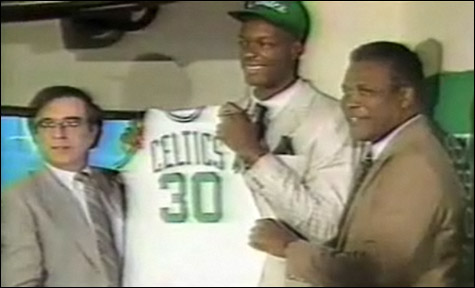
EMPTY PROMISE: Just 48 hours after being selected second in the 1986 NBA draft, Len Bias (center) was dead of a cocaine overdose, leaving basketball fans everywhere wondering what might have been. |
It wasn’t quite the world-shattering, where-were-you-when moment as the space shuttle Challenger exploding into cottony plumes earlier that year. But I still remember my naive and dazed disbelief upon hearing that basketball star Len Bias had died of a cocaine overdose on June 19, 1986.
I was 10 years old, and a bigger Celtics fan than I am now. I wore an unfashionable and ill-fitting green-corduroy cap, and that T-shirt with goofy caricatures of the Big Five and K.C. Jones. I drew Lucky the Leprechaun on my school folders.
And I, like everyone in New England, was certain that the Celtics were going to keep winning. Earlier that month, they’d beaten the Houston Rockets in six games, thus earning their record 16th championship banner. Now, improbably, they had the number-two pick in the NBA draft.
And they knew just who they wanted: six-foot, eight-inch University of Maryland forward Len Bias.
“I remember when people used to play basketball in my neighborhood and went up for a shot, they used to always say, ‘Bias!’ ” says Maryland-raised filmmaker Kirk Fraser. “When they did a jumper or a lay-up, it was ‘Bias!’ ‘Bias!’ ”
Fraser’s heartbreaking, thought-provoking documentary Without Bias premieres Tuesday on ESPN as part of the network’s “30 for 30” project. The brainchild of Boston-bred über-fan and espn.com columnist Bill Simmons, the documentary series celebrates ESPN’s three decades by inviting 30 skilled filmmakers to tell 30 compelling sports stories from the past 30 years to which they have a personal connection — and giving them carte blanche: Albert Maysles on Muhammad Ali and Larry Holmes, John Singleton on Marion Jones, Spike Jonze and Johnny Knoxville on BMX pioneer Mat Hoffman, Morgan Freeman on the South African rugby team, Ice Cube on the relationship between the relocated LA Raiders and gangsta rap.
Simmons contends — perhaps a bit hyperbolically — that it represents “the greatest collection of filmmakers ever assembled under the same umbrella.”
Fraser, whose previous work was The Life of Rayful Edmond (a documentary on the infamous drug dealer who introduced crack to Washington, DC), mined similar territory in the Bias story, which sent shock waves through the sports world. Fraser’s film is a powerful reminder of just how slack-jaw stunned everyone was — in Boston, but especially in Bias’s home state of Maryland — when the star UMD forward went into convulsions and later died, not even 48 hours after being picked.
“I can still see him in his gray suit and his Celtics hat, a newly purchased suit, I believe,” the Boston Globe’s Bob Ryan tells the Phoenix. “I was doing some radio with WRKO in the old days, and I remember taking part in an interview with him, and he was beaming and he was ecstatic. Then he went off to a party — and we all know what happened after that.”
Fraser’s film also explores the repercussions Bias’s death had beyond the basketball court, and how they are still being felt nearly 25 years later: the athlete’s posthumous transformation from a hoops star into an anti-drug symbol, and the subsequent rush to pass clumsy drug laws, the poorly thought-out mandatory minimums that imprisoned legions of low-level — overwhelmingly African-American — offenders.